New - HDTV via satellite
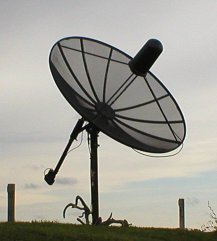 |
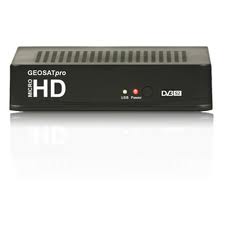 |
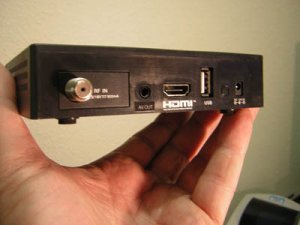 |
 |
 |
 |
| Years ago, many of us spent a lot of money to install a big satellite dish in our yard in order to get a broader choice of television programming than was locally available at the time. Since then, most have been superseded by the smaller digital DSS dishes and the larger dishes are often sitting idle, no longer used.
Today, there is an option that allows those of us with a big dish to once again enjoy the "old days" of plentiful free to air (FTA) television. The old analog receiver is usually all that prevents an otherwise intact functioning system from being used again. New Diseqc big dish mover controllers are available to operate the larger C band screw jack dish movers. They can operate stand alone or with the new receivers. |
New digital HD satellite TV receivers are affordable as well as very versatile.
For example, the GeoSat Pro receiver pictured above is my new favorite and sells for about $125 at Sat AV. Size not withstanding - what sets it apart from most other FTA receivers is it's probably the most sensitive I've ever seen. It has an external switching type power supply and a very friendly user interface via the remote. Designed by and for free to air enthusiasts, it's designers and technical support are here in the USA! In addition, it also has a build in DVR designed to use an external powered USB drive. |
| Like television, satellite feeds have switched from analog to digital - mainly because they can send several channels using the same transponder bandwidth as a single channel of analog television. This is possible because digital signals can be compressed - meaning they take up much less "room" compared to analog signals.
|
Now, the broadcasters are switching to HDTV and several of the freely available channels are in that mode. Unfortunately, the older digital receivers won't decode these new signals, so you will need the newest generation hardware to watch. |
Big dishes come in two varieties - C band only and dual C/Ku band systems. Digital signals are found on both bands and to get the most variety, a dual C/Ku band system is preferred.
However, to get started, a single C band system will work fine. Presently, most of the HD feeds are on C band, but I suspect that will change as more feeds are sent in the HD format.
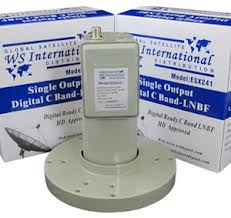
|
Recently introduced - On the left, C and C/Ku band voltage switched polarity feed horn/LNBs. One of them along with a VBox dish mover control on the right, will allow the new receivers to work with the big dishes without the old receiver. This under $100 solution has become popular and most FTA satellite dealers carry these items. 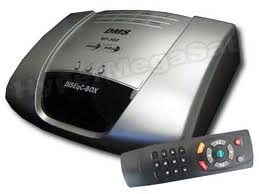
|
| The biggest complaint with early digital satellite receivers was how hard it was to find the programs. This is because many channels can be on one transponder frequency. To separate them, we must know the symbol rate as well as video and audio PID information. The new generation of FTA receivers have solved this hassle with a feature called Blind Search. |
Briefly, blind search scans all the transponders on a satellite for digital signals and stores the results in an ordered list. Afterwards, you can surf through this list and edit it down to what you like. For the audiophiles there are also oodles of digital radio stations to be found in almost every listening format. The links at the bottom of this page will answer many more of your questions. |
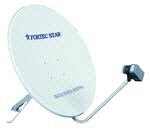 |
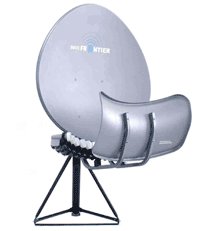 |
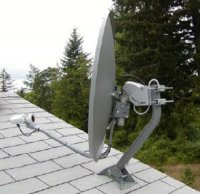 |
| For folks who don't have a big dish there's a couple of options. If you have the room, you might consider buying a used big dish and installing it. Often they can be had for little or nothing because the owner just wants to get rid of it. The downside to this is the equipment will probably need some repairs and you may have to install a new feed horn assembly to get the Ku band signals. In short, it can be a lot of work, but will give the greatest selection of free programming and flexibility. |
The second option is a Ku band only system. A basic arrangement like the fixed position dish on the left and receiver starts out at about $250. This setup works best if there's one particular type of programming you're looking for and you're not interested in scanning all the satellites. Otherwise, a toroid design like the one pictured above can receive multiple satellites in a 40 degree arc. The LNBs are arranged in the feed array to pick up the desired satellites. These LNBs are connected to a selector switch that is controlled by the receiver. No moving parts! |
The third option is a small Ku dish like the one above with a dish mover attached. For a little over $100 you can add a mover to a fixed position Ku dish and be able to cover the entire visible satellite arc at your location.
Most digital receivers come equipped with DiSEqC 1.2 which is the signaling method used to control the mover and signal polarity through the coaxial cable. Today, this is by far the most popular configuration because it delivers the most programming variety for the cost. |
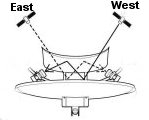
Useful Digital Satellite Links
INFORMATION
Satellite Guys - A Great Satellite Site
Hypermegasat - An FTA Equipment Dealer
This page was updated 10-29-2012